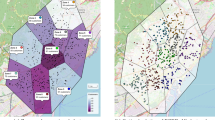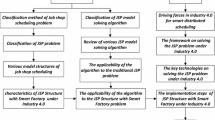Abstract
In this paper, we study a task scheduling problem in a home care business. The company has a set of supervisors in charge of scheduling the caregivers’ weekly plans. This can be a time-consuming task due to the large number of services they work with, as well as the need to consider user preferences, services required time windows and travel times between users’ homes. Apart from that, it is also important to have a continuity of care, i.e., that users generally prefer not to have their caregiver changed. This problem involves both route planning and employee task planning, which are usually very challenging. We first propose to model it using integer linear programming methodology. Since the real instances that the company needs to solve are very large, we design a heuristic algorithm, based on the simulated annealing philosophy, that allows the company to obtain the caregivers’ weekly schedules. Lastly, we check the algorithm’s good performance, by comparing the solutions it proposes with those provided by the integer linear programming methodology, in small size problems, and we present a case study to confirm that the algorithm correctly solves real-life instances.







Similar content being viewed by others
Notes
Sometimes it is specified by the user, sometimes it is estimated by the company based on its experience in similar services.
In this paper we use the female gender in a generic way. In any case, most of the caregivers in Mayores are women.
Note that to model the problem under study, instead of working with the users, we work with the services they require. Since the model depends on many factors, such as the availability of caregivers and users, it is possible to find solutions where a user will be served by more than one caregiver over the course of a day.
To simplify the notation, we define the affinity levels between caregivers and services (instead of users). Note that the resulting problem is, in fact, more general than the one presented by Mayores. In practice, we associate to each caregiver and service the affinity level between the caregiver and the user requiring the service.
By available caregivers we mean that they do not surpass their daily maximum number of hours allowed.
Note that we executed the algorithm to solve the incidents for the whole week, not just for one day.
References
Fikar C, Hirsch P (2017) Home health care routing and scheduling: a review. Computers & Operations Research 77:86–95
Paraskevopoulos DC, Laporte G, Repoussis PP, Tarantilis CD (2017) Resource constrained routing and scheduling: Review and research prospects. Eur J Oper Res 263(3):737–754
Bachouch RB, Guinet A, Hajri-Gabouj S (2011) A decision-making tool for home health care nurses’ planning. Supply Chain Forum: An International Journal 12(1):14–20
Cappanera P, Scutellà MG (2014) Joint assignment, scheduling, and routing models to home care optimization: a pattern-based approach. Transp Sci 49(4):830–852
Carello G, Lanzarone E (2014) A cardinality-constrained robust model for the assignment problem in home care services. Eur J Oper Res 236(2):748–762
Rest KD, Hirsch P (2016) Daily scheduling of home health care services using time-dependent public transport. Flex Serv Manuf J 28(3):495–525
Duque PM, Castro M, Sörensen K, Goos P (2015) Home care service planning. The case of Landelijke Thuiszorg. Eur J Oper Res 243(1):292–301
Braekers K, Hartl RF, Parragh SN, Tricoire F (2016) A bi-objective home care scheduling problem: Analyzing the trade-off between costs and client inconvenience. Eur J Oper Res 248(2):428–443
Eveborn P, Flisberg P, Rönnqvist M (2006) Laps Care—an operational system for staff planning of home care. Eur J Oper Res 171(3):962–976
Misir M, Verbeeck K, De Causmaecker P, Berghe GV (2010) Hyper-heuristics with a dynamic heuristic set for the home care scheduling problem. In: 2010 IEEE Congress on evolutionary computation (CEC), IEEE, pp 1–8
Nickel S, Schröder M, Steeg J (2012) Mid-term and short-term planning support for home health care services. Eur J Oper Res 219(3):574–587
Rasmussen MS, Justesen T, Dohn A, Larsen J (2012) The home care crew scheduling problem: Preference-based visit clustering and temporal dependencies. Eur J Oper Res 219(3):598–610
Kirkpatrick S, Gelatt CD, Vecchi MP (1983) Optimization by simulated annealing. Science 220(4598):671–680
Acknowledgements
This work has been supported by the ERDF; the MINECO/AEI grants MTM2014-53395-C3-1-P, MTM2017-87197-C3-1-P and ITC-20151247; and by the Xunta de Galicia (Grupos de Referencia Competitiva ED431C-2016-015 and Centro Singular de Investigación de Galicia ED431G/01). The authors would like to thank two anonymous referees for their very helpful suggestions to improve this article.
Author information
Authors and Affiliations
Corresponding author
Additional information
Publisher’s note
Springer Nature remains neutral with regard to jurisdictional claims in published maps and institutional affiliations.
Rights and permissions
About this article
Cite this article
Méndez-Fernández, I., Lorenzo-Freire, S., García-Jurado, I. et al. A heuristic approach to the task planning problem in a home care business. Health Care Manag Sci 23, 556–570 (2020). https://doi.org/10.1007/s10729-020-09509-1
Received:
Accepted:
Published:
Issue Date:
DOI: https://doi.org/10.1007/s10729-020-09509-1




